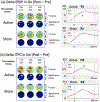High-definition transcranial direct current stimulation modulates theta response during a Go-NoGo task in traumatic brain injury
- PMID: 36108520
- PMCID: PMC10545365
- DOI: 10.1016/j.clinph.2022.08.015
High-definition transcranial direct current stimulation modulates theta response during a Go-NoGo task in traumatic brain injury
Abstract
Objective: High Definition transcranial Direct Current Stimulation (HD-tDCS) has been shown to improve cognitive performance in individuals with chronic traumatic brain injury (TBI), although electrophysiological mechanisms remain unclear.
Methods: Veterans with TBI underwent active anodal (N = 15) vs sham (N = 10) HD-tDCS targeting the pre-supplementary motor area (pre-SMA). A Go-NoGo task was conducted simultaneously with electroencephalography (EEG) at baseline and after intervention completion.
Results: We found increased theta event-related spectral perturbation (ERSP) and inter-trial phase coherence (ITPC) during Go in the frontal midline electrodes overlying the pre-SMA after active HD-tDCS intervention, but not after sham. We also found increased theta phase coherence during Go between the frontal midline and left posterior regions after active HD-tDCS. A late increase in alpha-theta ERSP was found in the left central region after active HD-tDCS. Notably, lower baseline theta ERSP/ITPC in the frontal midline region predicted more post-intervention improvement in Go performance only in the active group.
Conclusions: There are local and interregional oscillatory changes in response to HD-tDCS modulation in chronic TBI.
Significance: These findings may guide future research in utilizing EEG time-frequency metrics not only to measure interventional effects, but also in selecting candidates who may optimally respond to treatment.
Keywords: EEG; Electromodulation; Go-NoGo; HD-tDCS; Pre-SMA; TBI; Veterans; tDCS.
Copyright © 2022 International Federation of Clinical Neurophysiology. Published by Elsevier B.V. All rights reserved.
Conflict of interest statement
Declaration of Competing Interest The authors declare no known competing financial interests or personal relationships relevant to the work.
Figures







Similar articles
-
Multitarget high-definition transcranial direct current stimulation improves response inhibition more than single-target high-definition transcranial direct current stimulation in healthy participants.Front Neurosci. 2022 Jul 29;16:905247. doi: 10.3389/fnins.2022.905247. eCollection 2022. Front Neurosci. 2022. PMID: 35968393 Free PMC article.
-
Effects of anodal transcranial direct current stimulation over motor cortex on resting-state brain activity in the early subacute stroke phase: A power spectral density analysis.Clin Neurol Neurosurg. 2024 Feb;237:108134. doi: 10.1016/j.clineuro.2024.108134. Epub 2024 Jan 26. Clin Neurol Neurosurg. 2024. PMID: 38335706 Clinical Trial.
-
Baseline delayed verbal recall predicts response to high definition transcranial direct current stimulation targeting the superior medial frontal cortex.Neurosci Lett. 2021 Nov 1;764:136204. doi: 10.1016/j.neulet.2021.136204. Epub 2021 Sep 1. Neurosci Lett. 2021. PMID: 34478816
-
High-Definition Transcranial Direct Current Stimulation Improves Decision-Making Ability: A Study Based on EEG.Brain Sci. 2023 Apr 8;13(4):640. doi: 10.3390/brainsci13040640. Brain Sci. 2023. PMID: 37190605 Free PMC article.
-
The Effect of a Single Session of Non-Invasive Brain Stimulation on Balance in Healthy Individuals: A Systematic Review and Best Evidence Synthesis.Brain Connect. 2021 Nov;11(9):695-716. doi: 10.1089/brain.2020.0872. Epub 2021 Sep 3. Brain Connect. 2021. PMID: 33798002
Cited by
-
High definition transcranial direct current stimulation as an intervention for cognitive deficits in Alzheimer's dementia: A randomized controlled trial.J Prev Alzheimers Dis. 2025 Feb;12(2):100023. doi: 10.1016/j.tjpad.2024.100023. Epub 2025 Jan 1. J Prev Alzheimers Dis. 2025. PMID: 39863318 Free PMC article. Clinical Trial.
-
A modified neural circuit framework for semantic memory retrieval with implications for circuit modulation to treat verbal retrieval deficits.Brain Behav. 2024 May;14(5):e3490. doi: 10.1002/brb3.3490. Brain Behav. 2024. PMID: 38680077 Free PMC article. Review.
-
Posttraumatic reexperiencing and alcohol use: Mediofrontal theta as a neural mechanism for negative reinforcement.J Psychopathol Clin Sci. 2025 Apr;134(3):308-318. doi: 10.1037/abn0000925. Epub 2025 Feb 3. J Psychopathol Clin Sci. 2025. PMID: 39899115 Free PMC article.
-
Cognitive control subprocess deficits and compensatory modulation mechanisms in patients with frontal lobe injury revealed by EEG markers: a basic study to guide brain stimulation.Gen Psychiatr. 2023 Sep 14;36(4):e101144. doi: 10.1136/gpsych-2023-101144. eCollection 2023. Gen Psychiatr. 2023. PMID: 37720910 Free PMC article.
References
-
- Benton LA, Hamsher K, and Sivan AB (1994). Multilingual Aphasia Examination. AJA Associates: Iowa City, IA.
Publication types
MeSH terms
Grants and funding
LinkOut - more resources
Full Text Sources
Medical

